#mostly practicing using shapes and lines of action for characters
Explore tagged Tumblr posts
Text
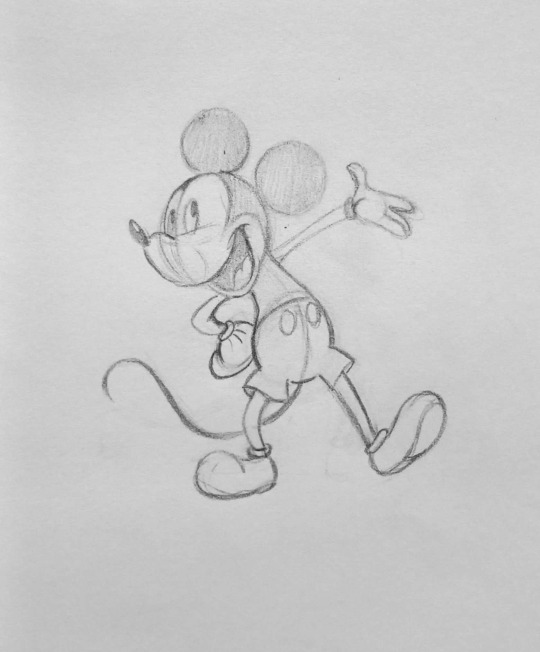
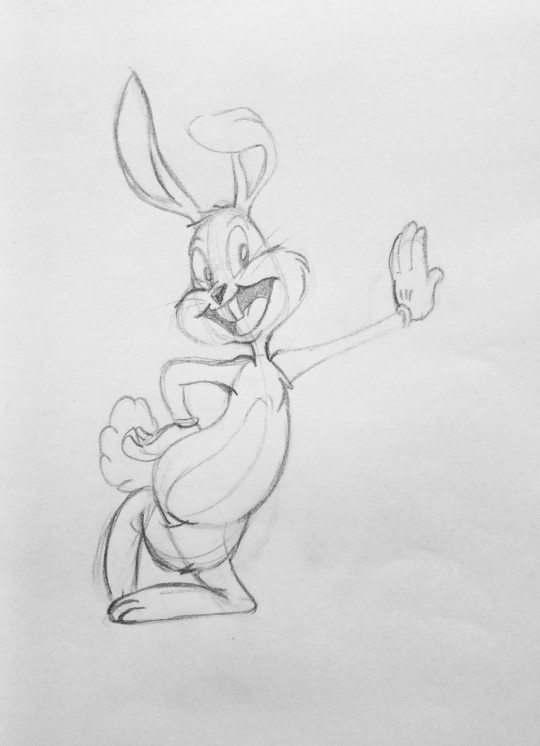
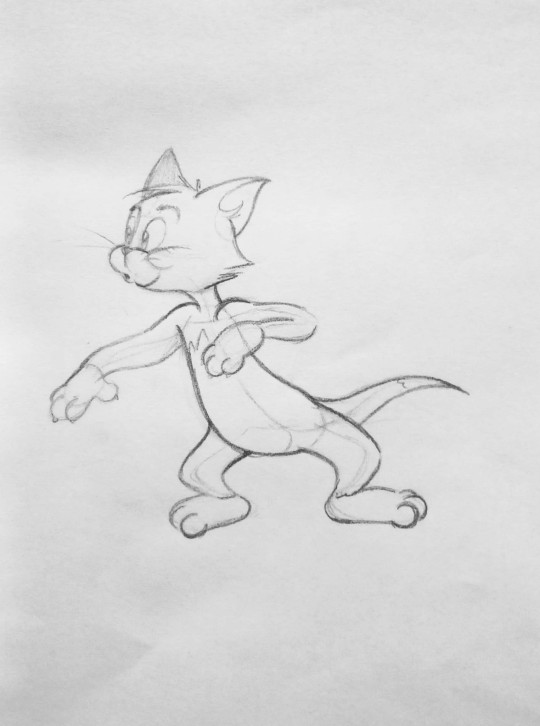

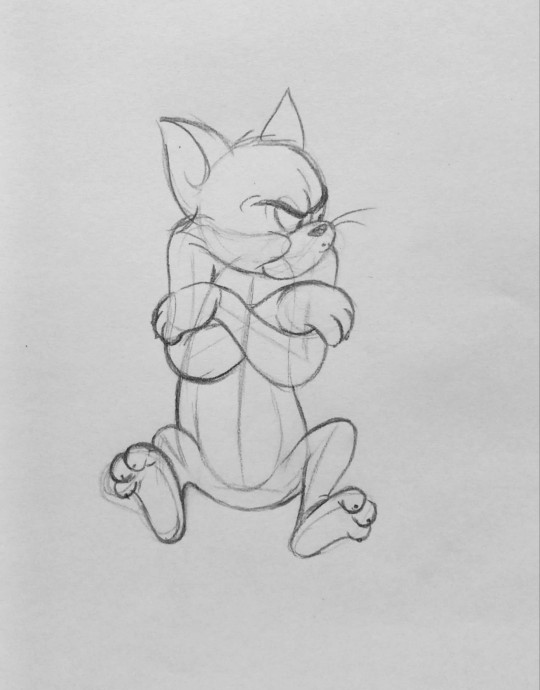

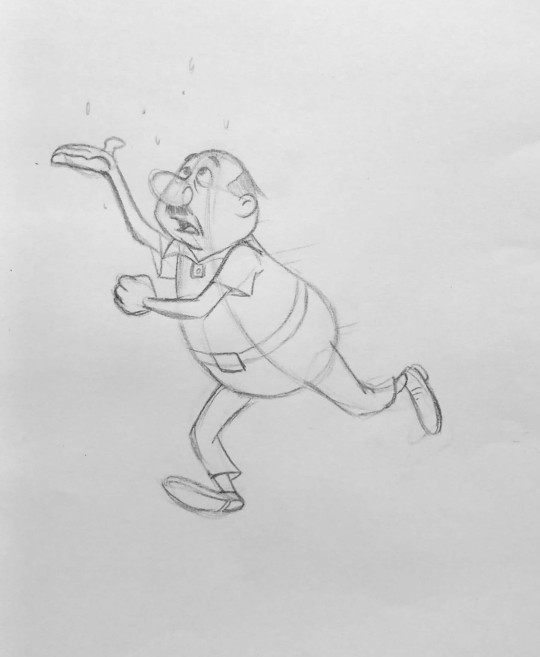
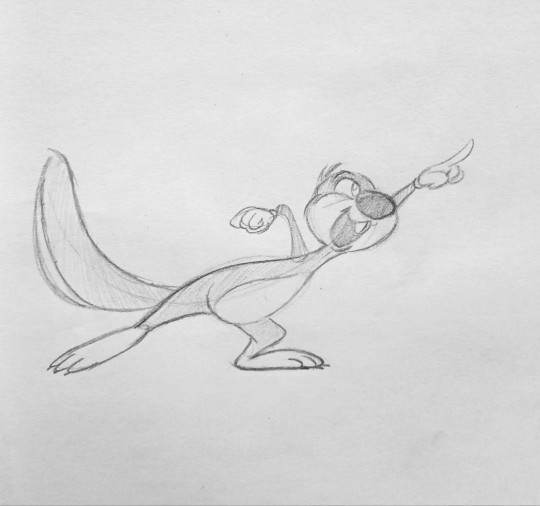
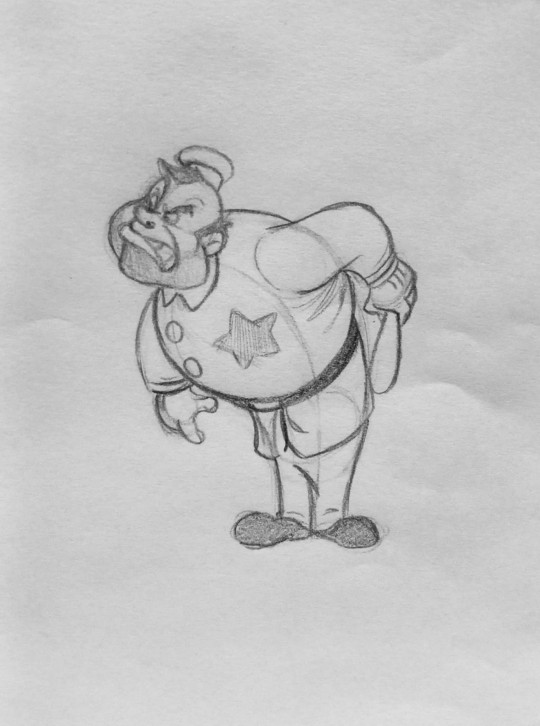

my mom reminded me to share my drawings with the world xd
so here i show you some of my homework!
#mostly practicing using shapes and lines of action for characters#all of em made at like- 4am#because i forgor#to make them#on time#...anyways#character design#character art#myart#hand drawings#cartoon characters
30 notes
·
View notes
Note
I just wanted to say that you've greatly inspired me to start working on my own clangen comic!! I'm TERRIBLE at drawing cats, so when I first started reading clangen comics I figured I would never make one. But yours was the first one I read that wasn't based off "cats" per se. After I read yours I sought out more clangen comics that didn't feature cats, and I finally started my own!! @scaleclan-clangen (I'm still not very good at drawing in general, but better dragons than cats haha). Obviously you don't have to respond, but if you do choose to, then I would love to hear any tips that you may have!
Oh dragon clangen that's so neat! 🐉
I'm definitely not the first to use non-cats for a clangen, so i can take 0 credit for that cx Even before I started there was at least a few around using other species (pigeons, wof dragons and chickens off the top of my head), I think there's even one using inanimate objects out there!
I've done a few comic/clangen tip asks but as for art advice, it's tricky because it's mostly the same old "practice always" cx
For dragons specifically I can give one bit of personal advice which is: References are great even if you're drawing a made up animal!
Find a living creature with similar anatomy even just in one area (wings/legs/head/etc) and boom, references! I originally learned to draw almost exclusively from my silly original species so this does work I promise cx
Something I always say is "if you used a reference and it still looks wrong, it is". Which is to say, use references but don't marry yourself to them, go with what looks right! Usually I find a couple of similar ones and draw from both, rather than replicating one completely. When I'm drawing a particularly in-depth pose (such as Poppy hunting in Moon 8) I often try to find a video of the moments surrounding it, to get a better idea of movement. Also the line of action is your friend and it's Not just relevant in animation, it will also make your still drawings hold more motion c:
When learning a new species, or a particularly hard pose, I'll often doodledump loosely from a reference then put that reference right next to the doodle to compare where I went off.

This way you get a better feel for shapes than you would from tracing (which isn't The Devil, but should be used sparingly), and better proportions than just loose referencing c:
don't try to work out who the characters are i intentionally anonymised them rjhrfh
#mammothask#pav chatter#clangen#sabercat#anon#ooc ask#clangen tips#art advice#you could call it a... padvice column#no ok that doesn't work i tried though#scaleclan-clangen#ice fang#fleet fang
30 notes
·
View notes
Note
Weird question for you 👉👈 do you have any drawings of the lamb or narinder like, naked? NOT in a horny way I SWEAR, I love your style and I just wanna see how you draw their legs lmao, I can't figure it out myself and other artists I can find are like, too human.
(nakey animals ahead)
Okay, so to preface this I'm a hobbyist artist who commits anatomical atrocities for shits & giggles, and this is by no means a professional/accurate way to draw animals, humans, or any combination of the two. This started as me struggling to explain how I draw instead of just sticking to the most brutally honest explanation of "I just wing it", but having to draw out different parts of anatomy and how proportional they are to each other was hugely helpful to help me re-evaluate how I draw animals. So thank you.
I'll be mostly using Lamb and Narinder for reference, because the brainrot is strong and they're what I draw the most.
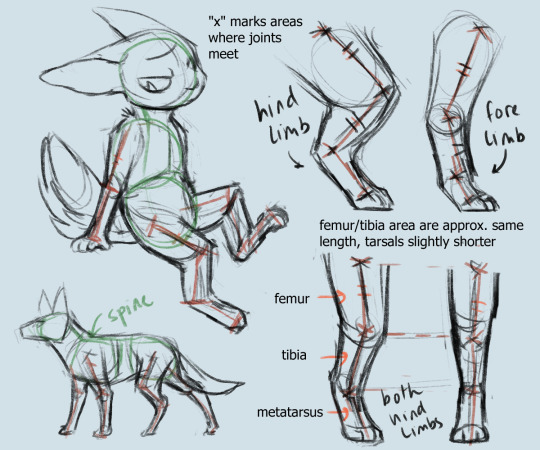
A lot of my style comes from the fact that I'm primarily an animal artist, not a human one. In fact, COTL's the first fandom that I've drawn anthro characters in, and it was a trial trying to adapt what I know to upright animals.
Best way to get a better grip on anatomy is to sketch from references. Nothing that can really replace practice. It's helpful to look at skeleton and muscle diagrams and get a good idea of where body parts are in relation to each other. Then, search up actual references and try to overlay the shapes and bones onto them. When I'm not sure if something of mine is proportioned correctly, I just measure something with my fingers and compare.
Some specific things to note: generally, the hind legs of quadrupeds have a larger metatarsal area (the large flat portion of your foot) compared to humans--that's why people say cats tip-toe. Humans have theirs relatively short; how long you make that area largely determines how Creature the design looks. I know some people who draw purely human legs, some who draw human legs then add the extra foot length on top, all of that's fine. Personally, I will shorten the leg length above the knee to compensate. In quadrupeds, the knee will draw up very close to the torso area, as you can see in the jackal doodle.
Another note: when standing, it's important give the impression that there's a center of balance. When standing straight, a straight line drawn from the hip to the foot of a leg should be relatively perpendicular to the ground.
(Of course this all goes out the window the moment anything other than standing straight is involved but w/e.)
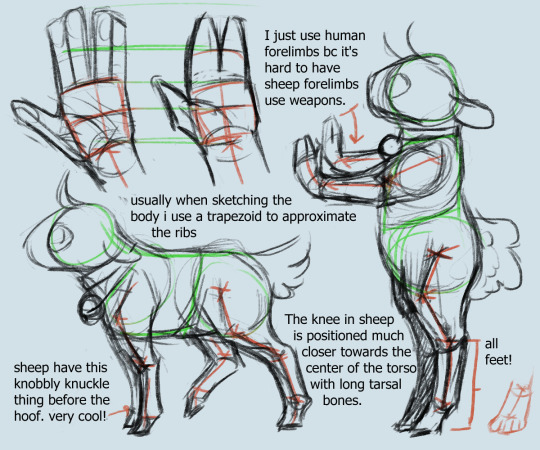
A lot of the fundamentals carry over between my quadruped and anthro art: the general shapes, the proportions, etc. One thing I noticed while sketching Lamb is that sheep have a femur that's almost entirely against their torso, and their legs are mostly just the tarsal parts (sorry if I'm butchering the anatomy).
For the arms/forelimbs, I mainly just use human anatomy with a repurposed number of fingers. It's easier, plus I can't exactly have a sheep with sheep limbs carry an axe around. I mean it's doable, just kinda awkward.

After getting the basics down, I move to more complex poses. One thing I struggle massively with is anything involving knees--kneels were something that eluded me for months. There are things that humans do that look very awkward when you factor in other animals' anatomies. I'm not super good with action poses so I can't really say how I've overcome that limitation, because I haven't :'D.
When I'm doing more simplistic poses, I just result resort to drawing a slightly bent line and calling it a day. You don't see much outside clothing anyways.

Last thing I found interesting: because of the weight distribution, the positioning of the arms in relation to the torso is different in bipeds and quadrupeds. Drawing anatomy with arms that kinda come forward and legs spread apart give designs a more animalistic vibe to me.
#long post#my asks#my shit#idk if this helps or not#it's just how i draw things not how to draw them correctly#i wrote this at 3am so it may make no sense whatsoever oops#but yeah i don't really??? do consistency??? so i constantly violate my own rules#reminder that my narinder is a jackal/cat hybrid#cw suggestive#not rlly but just in case
41 notes
·
View notes
Text
I'm a little late to the #webcomicday party but I still thought it'd be fun to break down my process a little bit using the latest Way Out chapter as an example!
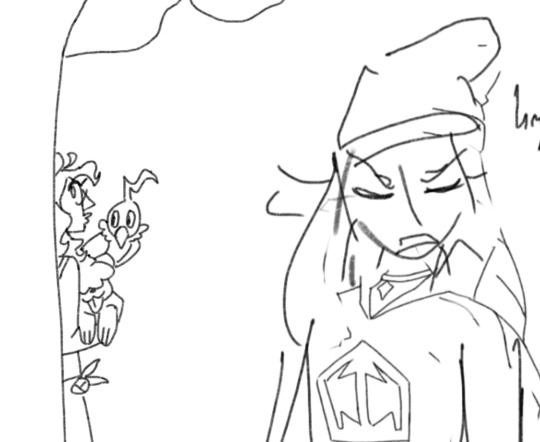
So I have a rough outline for the whole comic but I don't go into too much detail planning each story arc until I'm about to get stuck into it. The rough outline is for jotting down ideas as they come along, acting as a skeleton for what will eventually happen, while the more detailed arc outlines are for plotting and pacing the story beats.
Planning each chapter out like this means that each one feels like its own mini-story, and more importantly, stays on track and achieves something to further the story or character progression. You'll notice that the chapter notes are still pretty barebones, which leaves me room to fine tune the smaller beats within the script.


Then, it's scripting time! I'll only have a script for the chapter I'm working on and a script for the next chapter, so as I'm currently working on Chapter 66 I have a script for chapter 66 & 67 but not 68. This is ideal for me in keeping the story flexible, allowing me to take a chapter in a bit of a different direction without feeling tied to a whole arc's worth of scripts that I'll need to rework otherwise.
Around 20 panels is the sweet spot for a chapter of Way Out; there are some with fewer and some with more, but shooting for that number makes me think about whether a scene ought to be extended or cut down in order to meet that goal. If I only plan out 18 panels then I can probably squeeze something extra in, while if I plan out 23 panels, I have a look and see if there isn't anything that can't be condensed.
The scripts themselves are pretty sparse, mostly just dialogue with basic action notes that I highlight as I finish. I'm usually pretty good with visualising things in my mind so the notes are more of a reminder to self about angles & expressions more than anything- if this were a collaborative project I'd probably put more effort into making it descriptive, but it's not.

I've never been one for thumbnailing, which is bad comic practice, I know. But once I have my script I just want to get stuck straight into drawing and don't like slowing down to jot down what is already pretty vivid in my head when I can just. draw the thing.
(a large part of why I started my first webcomic in the vertical format is because you don't need to consider variety in panelling and page flow, which is something thumbnails are very important for).
And so the sketching begins! My sketches are rarely pretty with little focus on anatomy and shape and more focus on blocking and size. I use Procreate to draw the panels and its resizing tool has a tendency to obliterate the quality, which I can sharpen in small amounts but it saves a lot of pain if I plan it all out in the ugly stage.
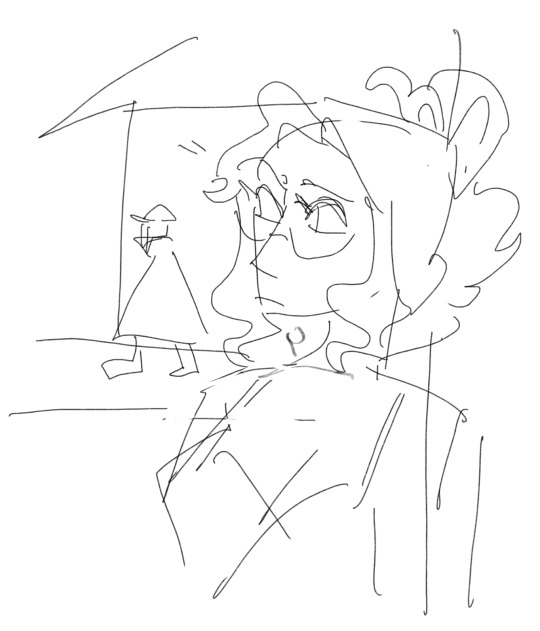
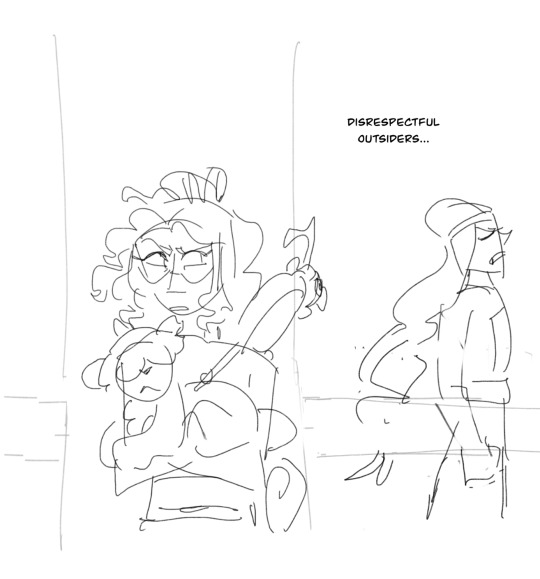

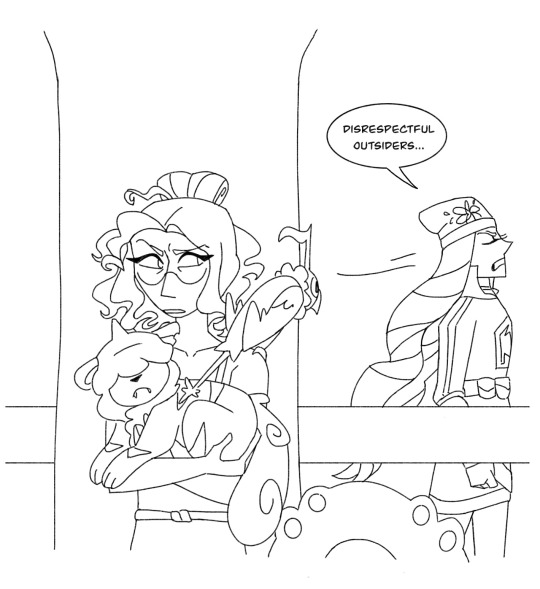
In some ways I often prefer the sketches to the clean lineart, but that's mostly the stylistic scratchy-ness of it that I have to do away with in favour of clean lines. I'm not always super proud of the art in the end but not every panel needs to be a masterpiece and it's all practice. I think a quantity over quality approach is kind of necessary if you want to make a comic and not lose your mind.
I sharpen up and clean any spots up as I go, but once they're all done I glue all the panels together on my desktop so that I can adjust the spacing between them, then I cut them back up again into smaller slices for posting! And that's the whole chapter process!
I also have a quick (and by quick I mean 4 minute) rough timelapse of chapter 65's coloured panel I can post, if anyone would be interested in seeing that, but it'll probably need to be its own post bc it'll crash this one.
10 notes
·
View notes
Text
Comparing Animorphs to Worm
The first comparison is my relation to the series. (Serieses? How do you pluralize that word?) I was obsessed with Animorphs in grade school, starting younger than my parents probably would have allowed if they were familiar with the books. (I knew the name "Scholastic" from these books before my first Scholastic book fair, which should tell you a lot, if kids these days still have Scholastic book fairs.) I was obsessed with Worm immediately before and during college, shaping the way I engage with fiction and fandom to this day.
That's one of the reasons I'm comparing the two series, but there are plenty of other comparisons. Their teenaged protagonists, their heavy subject matter, the stories framed in an almost YA format that slowly peels away like old paint over rusty metal, the planetary threats from outer space...
And of course, the characters.
The Heart
This might sound weird if you're used to the fanon versions of Cassie and Taylor—the former being a weak-willed hypocrite who's constantly whinging about whether they're doing the right thing, the latter being Chuck Norris if he was a war criminal and controlled bugs. But they're very similar characters.
Superficial stuff out of the way: They're both unpopular introverts with unusually strong connections to animals, and end up in a messy interracial relationship with their team leader.
Now onto their shared core. They both have a powerful moral compass, which slowly warps under the pressures of the violent plotlines they're involved in without completely vanishing—even when they commit acts of shocking brutality.
Cassie's character arc is relatively simple. She's reluctant to hurt anyone, even Yeerk soldiers and especially their Controllers. She's so reluctant that she leaves the team in the first third of the series. But she also comes up with a lot of really concerning ideas for the group, including David's fate (I'll come back to this).
As for Taylor? She starts out joining a villain team to help the local superheroes, and becomes the voice of caution and moderation pretty much immediately. She also comes up with some pretty brutal ideas for the Undersiders, albeit mostly ones she implements herself.
As far as this aspect of their characterization goes, the big differences is where their moral compasses go in the end. Cassie becomes more comfortable with the moral compromises required by war, but not completely comfortable. She's always at least a devil's advocate, but she doesn't start arguments every time the animorphs need to premeditate their violence.
On the other hand, Taylor falls face-first into moral decay, whittling away at her moral beliefs until she finds the unbending core that she refuses to compromise. And a big part of that is critiquing inaction as strongly as action. People who could have stopped something but chose not to are as culpable as people who actively choose to cause it. That's part of why Taylor is as ruthless as she is, in the "seeing the bright clear line that goes from motive to means" sense.
Both of them also have strong self-sacrificial tendencies. Taylor's are front and center (our girl is practically jumping at martyrdom from her first night in costume) but Cassie is also willing to sacrifice herself for her beliefs. She traps herself in caterpillar morph to prove her conviction to a Yeerk, which is a pretty serious sacrifice since she didn't know she could demorph after metamorphosis. (...yeah, for all its darkness, Animorphs is still a YA series.)
Oh, and they also have a strong friendship with the team's pretty blonde extrovert and its violent butch bitch. But for Cassie, they're the same person.
The Big Guy
Rachel and Rachel are both the most violent members of their teams, but their arcs go in different directions.
Rachel Berenson started as the pretty popular mall-loving cheerleader gymnast type, but started sliding into blood knight territory as she adapted to the war.
Rachel Lindt, on the other hand, starts out antisocial and violent, and she only starts getting friends and finding a more comfortable, less violent life after meeting Taylor (and, to an extent, the other Undersiders). Rachel climbed out of the pit that swallowed Rachel whole.
This comparison is a pretty obvious one...probably the only obvious one.
The Leader
We're getting to the part where it's hard to compare Animorphs to Undersiders; I don't think I have any substantive comparisons to make between the other halves of their team. (You could make comparisons between Marco and Lisa, or maybe Alec or Aisha or Taylor; Tobias turning into a bird is kinda like Taylor's cape escapism but they go different directions; and Ax is too literally alien to have a clean parallel with the earthly Undersiders, except maybe Alec.)
But I think there's something between Jake and Brian, beyond their shared status. For starters, neither one wants to be a leader. Jake chafes at the title of Prince, and Brian stubbornly refuses to take sole responsibility for the Undersiders. In both cases, this flattens their team's hierarchy. Jake and Brian help set the agenda and direct discussions, but they don't force their will on the group if they can avoid it.
They also care strongly about their family, especially their siblings, Tom and Aisha. They're putting their lives in danger in large part for those siblings—rather more directly for Jake, whose brother has a Yeerk in his brain, but Brian explicitly says he became a supervillain to provide for his kid sister. (Which is a lot funnier from an outside perspective, since both of their parents are alive.)
The big differences are age (Jake is 13-16; Brian is 17-18 pre-timeskip) and the scope of what they care about. Brian is very clear; he cares about his family, he cares about his friends, but the rest of the world can sort itself out. Jake, on the other hand, knows he's on a mission to save the world and acts accordingly.
But if Brian was a few years less jaded, and given the nearly sole mandate to defeat a threat to the entire human race...I think he could end up a lot like Jake. War crimes and all.
The Traitor
David and Cherish were both trapped just offshore by the team they betrayed, and their screams can sometimes be heard by people on the shore.
David's fate is a bit less nightmarish (he's a rat on an island instead of a brain in a box) and his screams are less deadly, but the fact that I'm comparing something the Animorphs did to something the Slaughterhouse Nine did should indicate how dark the books can get when they aren't engaging in instant maple-ginger oatmeal shenanigans.
If I reread the series, I could probably come up with more comparisons. But for one Tumblr post, I think this is enough.
17 notes
·
View notes
Text
LinkedIn Learning: Gestures with Andrew Gordon
Gestures are communications and signals that portray how a character is feeling or thinking. These are natural processes in human subconscious, so including gestures in animation makes a character believable and realistic. Gestures can be stylised, much like acting. Over time, styles and performance are over developed and overused, and it is important to avoid a cheesy and cliche animation. Gestures can be primary or secondary actions, either portraying the overall emotion of a character or more subtly, portraying the way a character’s personality comes across. Gestures change with distance similar to how acting is different on stage which is far away for most of the audience, to on screen which is mostly close-ups. Actors on stage must exaggerate because their subtle facial expressions and minor gestures are not visible, whereas if a screen actor took the same approach, the film would be jarring, overly intense and unrealistic. Therefore, a screen actor’s gestures are much more tame.
Gestures are similar to punctuation at the end of speech, it adds complexity and completely changes how a line is delivered. Placement of gestures should also be considered in animation, how does that particular angle affect how the character delivers, the overall mood or the meaning behind the action?
Gestures must always be purposeful. If a character wants to present themselves in a certain way, maybe without displaying their feelings, they may have minimal gestures. Environments and props may also prevent a character from performing gestures so consider the realism of the situation. A lack of gesture in certain moments may create a comedic or dramatic effect, and plenty can be told to an audience with this contrast to more vibrant gestures.
More things to consider when establishing a gesture/pose:
- Musicality, patterns and shapes created with movement creates a realistic and engaging appeal.
-Twinning gestures, don’t be too robotic and symmetrical and be creative with in-between movements. We have dominant parts of the body, for example, a dominant hand or leg, a character is more likely to use this part of their body more drastically than the other.
-Don’t overcomplicate or include too many gestures, this makes a character more difficult to read especially if there are more characters or movements on screen. There should be one clear message when a character moves, with extra subtleties to display the character’s personality.
-Posture, fluidity and balancing a character (having a clear fluid line that passes through the entire body) makes a scene interesting and can tell more about the character than just using more commonly hands and face. Use the full body to make a character appear more like an individual.
-Once a gesture has been established, look at what would make it more visually appealing or realistic: Could the expression be exaggerated or pushed even further? Does the character feel alive in their environment and responded to it? Is there an appealing pattern? Can it be simplified? Can you break up the timing to communicate clearer? How can you complete a gesture whilst preparing for the next one?
During the lecture, I decided to look at the Lecturer himself, Andrew Gordon’s gestures. How does he communicate and teach using his facial expressions and body to keep himself interesting and in touch with the viewer? How does he stay knowledgeable and understandable through movement?
below are some drawings/ observations of subtle poses made by Andrew that I have exaggerated.


I then practiced what I learned by keying out clear gestures that all present a meaningful, singular emotion whilst create a fluidity between each movement.
The micro expressions of the writing hand and posture portray more than just what we read on the face. And as the character pushes themselves away from their desk, their movements get more dynamic since the micro expressions get lost in through distance. The character interacts their emotions through their environment and props, pushing away what is frustrating them, flicking the pen around as if it’s a part of their body and trying to stay calm in a moment of frustration by staying seated on the chair.
The two main gestures of leaning in and pushing away work fluidly together even though they both express different emotions. The lean in to the book out of confusion prepares and sets up the next gesture, anticipating a dynamic, charged up push away that explodes with frustration.






0 notes
Note
your art is absolutely breathtaking! do you have any tips for improving?
Hi!, thank you so much!!
Improvement takes quite a while so don't beat yourself up over it. Most of all I would recommend short daily practice using reference. But take breaks if you need to, don't burn yourself out.
Drawing from life is extremely valuable for developing your observational skills so I would recommend drawing your friends, objects from around the house, the view from your window or even yourself using a mirror.
Drawing from photos is also a very good way to improve, never ever feel bad for using references as every artist does it and it's incredibly helpful for improving the more technical skills of drawing.
For drawing the human body and characters (as thats mostly my thing) I would recommend drawing and studying the skeleton and muscle groups as it informs your drawing of the figure. I've made a post under #ask of all the figure reference resources I recommend so please check that out! Paying attention to things like line of action in the pose is helpful to me so sometimes drawing the shape of the pose and directions the body is leaning is a good way to start drawing gestures.
Also feel free to redraw art of artists you admire as long as you don't post them online, if you feel that their art will help you to learn its a good idea! This can also help you pick up on stylistic features you enjoy and can incorporate into your own artwork.
I hope this is helpful!!
61 notes
·
View notes
Text
Ancient Agricultural Rites Hiding in Plain Sight
Oral traditions are encoded in folklore that only makes sense if you understand the coding so looking at the practices themselves requires a bit of context. Folkloric coding is like slang but for actions. There is internal consistency to it and good reasons for all of it but it is not exactly intuitive. Every individual village or city that still has a tradition related to the agricultural mysteries (or collection of traditions) has a unique origin story for how it supposedly got started. In many cases these stories have changed over centuries, keeping the rituals relevant to whatever the living people of the region would most easily recognize but there is a common thematic "thread" and that is what you should keep an eye out for.
When it comes to the rituals I want to show you today, the story to look out for is:
A hero in red fights off an opposing army that represents the forces of death. There will always be a young woman whom they fight over, who represents the Spring or the Land itself.
There are several features that I keep an eye out for but things vary from place to place because this ritual is probably one of the oldest that I have been able to track. The older a practice, the more local variation. But this is what I look for:
Time of Year: Death Season. Between mid December to March for the procession of the armies of death. With a few specific battle rituals or bonfire night vigils around the time of planting and harvest. There are usually at least 4 major ritual occasions that frequently line up with the embertides. But some areas have a different calendar so that has to be taken into account.
Colors: Usually Red, White, Black, and sometimes Gold.
Dance Fighting Style: If there are two armies, the ritual will go thwack. They will fight each other in circles moving in procession from place to place to bless the town. Sometimes participants do get injured and that is expected, part of the ritual. At one time these rituals were used for divination but now they are mostly for sympathetic magic or just for the sake of tradition.
Shapeshifting/Transformation: The utilization of masks and very specific ornate clothing, almost always color coded into teams. There will usually be clearly defined "mummer" characters.
Spirit Weapon: The old traditional form was to use sticks or bound stalks of grain. Sometimes the armies of death will use cudgels of bone. In regions where the traditions have adapted more to a modern populace, they will have traded out for swords.
Rhythm: 1-2 1-2-3 is very common and prominent but there will almost always be some kind of triple beat that works out to move-strike-strike-strike or step-jump-jump-jump. There are usually an odd number of different ritual dances and sometimes they will have variations of the same rhythm so there is a spectrum to it. Big drums and pipes are traditional but so is music being made with jingles worn by the dancers and the rhythmic clacking of their weapons.
**The ringing of metal against metal is apotropaic so part of the purpose of the ritual is to process through the village/town ringing metal against metal to drive away malicious spirits. This is a ritual purgation of the space and a blessing. Sometimes the ritual characters will stop in front of various houses and important buildings in their path and bless the occupants and the structure with their encoded movements.
Who Gets to Participate: It is very important to the ritual that only locally born people perform these dances. They are the children of the local earth goddess. Participation in these rituals is not open to outsiders and the general public, though viewing is acceptable. Traditionally it is most frequently done by young unmarried men but since gender is one of the things shape shifted during this ritual, that may not matter as much in some places. At one time and still in a few places, the term of service would be 9 years. 9 being the number of transformation and ritually significant to lycanthropy traditions. Right now, many regions are scrapping the age and marital status aspect in order to keep these traditions alive. In the last 20 years or so these rituals have been opened to the public for viewing to boost tourism. In at least a few areas this has resulted in these rituals being staged multiple times per year (out of season) by professional companies or fraternities for the benefits of tourists.
Gods / Heroes Involved: Some areas still keep the legends tied directly to old gods while others just use code and do it symbolically. Sun gods and gods known to have gone into the underworld and returned are the most common, thus the red colors. But many living traditions have more modern origin stories (either layered on top of god legends or just replacing them). Some legends have switched to more recent characters, usually a Johnny "Good-Guy" McBeefcake coded person. This can be a named king or an archetype that everyone liked at the time vs. some military threat the local people faced that left an emotional scar on the town. Sometimes the two sides are led by brothers or twins--one solar coded and the other death coded. There are often a selection of goddesses operating in the background as well. One of those goddesses wields fire and releases the army of the dead around mid December. And, of course, there is always the Spring Maiden.
Shapeshifting traditions are occasions for elaborate and very specific regalia. So, colors are important and so are masks, and animal skins--usually worn over the head. In those cases, the person doing the shapeshifting takes on the attributes of the animal or the being that they are dressed as. There is a whole ritual process for who is supposed to do this, when they are supposed to do this, and there is always a proof of state involved. Proof of state is a common feature in all possession traditions, which shapeshifting/lycanthropy functions very similarly to. It will often involve the person doing the shapeshifting consuming something that they ordinarily would not or doing it in such a way that would be unusual outside of a ritual context.
When it comes to the mysteries of the grain cycle, there are two things commonly consumed by those who do the shapeshifting--wine and bread. On their own, this is not unusual. It is the quantity that these people consume and how they go about doing it that is the real proof of state. While in a state of ritual transformation, they consume bread and wine with the unrelenting, unquenchable thirst and hunger of the dead. Modern people usually translate this as "they feasted" which is quite the understatement. More like, "they ate everything that wasn't nailed down or hidden." And this wine connection, along with the undead associations related to shapeshifting, is what I think ties this to Dionysos and puts occasions like Anthesteria into proper context.
The bread of the dead is a whole thing. The dead want bread. It is just known. Death season is that time between what would be December and March, for those in the Northern Hemisphere. The dead are "controlled" by fire. So, pay attention to references to fire as they relate to life and death. Fire is used to bake bread. I know there is some kind of connection tying all of that together but I couldn't possibly phrase it well.
This was just the preamble. I haven't even started the dive yet. On that note, here we go!
youtube
Link #1: 'Ndrezzata of Ischia
The legend goes that Apollo played his golden zither and the nymphs of Ischia danced this dance. Then Apollo fell in love with one of them (Coronide), they were wed and had a son together (Esculapio). The wicked faun, Ischis, stole Coronide and in the fight between Apollo and Ischis, Coronide was tossed into the sea. Esculapio poisoned the spring of Ischia with herbs that filled hearts of the people who drank from it with hate. The two peoples of the area (ancient Murpano), the Baranesi and the Buonopanesi, both drank from it and it plunged them into an endless war. Frightened away by the war, the nymphs of Ischia abandoned the place but left their dance to the people there.
Here we have the red color coded hero-god figure and the wicked shapeshifter (faun), the two armies fighting it out over a local goddess (nymph in this case), the dances are definitely a variation of what I have come to expect (very strong resemblance to Moreska), and I can still hear the 1-2 1-2-3 in the striking of the batons. They are accompanied by drums and pipes. Glad to see they are still using wooden spirit weapons. The colors are a little different from what I would expect but this is a small island and maybe they happened to have an abundance of green dye. Totally within the spectrum of normal. Their goddess figure is removed by tragedy, effectively placing her in the underworld. And for whatever local reason there is, the heroic figures have departed leaving behind two opposing teams who are compelled by magical means to fight each other.
Next up!
youtube
Link #2: Janissaries & Boules of Naousa
This is the tradition of the Janissaries & Boules (Γενίτσαροι & Μπούλες) from the city of Naoussa in Greece. The character of the lead Janissary wears the bold red head scarf while the support Janissaries (his band of mountain bandits) support him in a slightly different shade of red. The Boules refer to the character of the young goddess/heroine who accompanies each troop. In the video there are many, many different troops so you will see several different Boules but they are all the same character. Her name is Boula and she dances with them and blesses people with kisses.
This ritual is tied to the god Dionysos. The procession order goes: children in the front, main body of Janissaries and Boules in the middle, musicians in the back. The ritual begins with the Janissaro appearing on the balcony or in the window of his home. He will vigorously shake his chest and jump three times on his two feet (1-2 1-2-3). Then he will go downstairs with Boula, cross himself 3 times at the door of his house and step out. Together they will bless the people who have gathered to see them with chest shaking, jumping, and Boula's kisses. They will then walk to the next house to pick up the other members of their "pack."
Once the pack is assembled (mountain bandits are often thought of as wolves) they all go together to the City Hall to wait for the town's blessing for them to begin their ritual dances. Once given, all of the packs will raise their swords and dance in circular patterns through the streets--stopping periodically to make blessings and shake/jump. This ritual takes a full day and it is repeated over 3 days. (Right around the time of Anthesteria.)
At the conclusion of the ritual everyone feasts (with the unquenchable hunger and thirst of the dead) on special grain cakes and wine. Do remember that the ringing of metal against metal is apotropaic so the movement of the coins and jewelry are specifically there to scare away malicious spirits. They do this through the whole town, clearing the spirits from the streets.
Looking at both 'Ndrezzata and the Janissaries & Boules. Even though no wolf-shapes or animal shapes are seen, they are still implied using the local folkloric coding. But if you don't know the coding or how this all fits into the bigger picture, then it is very easy to miss. Going up into the mountains is a major feature of these rituals, either in the background legend or as an actual thing still done as part of the ritual. Going into the mountains to fight spirits is one of the traditional roles of those involved in lycanthropy and shapeshifting traditions. Keep Apollo Lykaios in mind as well here.
Now we head over to Korcula, Croatia for some Moreska!
youtube
There are few dances in this world as grossly misunderstood and misdocumented as Moreska but I can understand how it happened. If you do a search for more information about Moreska or the origins of "Morris Dancing," you will get led off in all kinds of weird directions that take each origin story of these rituals at face value. (I have a very fancy dance encyclopedia set created by one of the big names in dance ethnology and it doesn't mention any of what I am about to tell you or what I have already told you.) This is a good example of what happens when outsiders take a look at the exact stated history of an indigenous practice and completely miss the coding. Never take this stuff literally.
Moreska is a ritual play. The main characters are:
Osman, the Red King
Otmanovic, the Black King
Moro, the Black Prince
Bula, the White Queen (same Bula as from the Janissaries & Boules ritual from Naoussa)
At the beginning of the ritual, Bula is abducted by Moro and taken away. The coding is that Moro is the Prince of Death and he has taken Bula (Spring) to the underworld. Osman is the local King/Prince and he descends into the underworld with his army of mountain men to rescue Bula and bring her back to the world above. Osman then has to battle the armies of King Otmanovic through 7 dances (battles). At the end, Osman defeats the army of the dead and releases Bula from her chains.
***
At some point these rituals seem to have been constructed with a divininatory purpose. The outcomes of the dance battles were not known and they could be used as a divination method to determine what kind of a year the locals were going to have. Whether there would be a lean harvest or whether there would be more sickness or death than usual. And that would allow them to strategize and prepare. But somewhere along the line the outcome of these rituals became fixed, with the red team always winning. And at that point it became a matter of sympathetic magic. They beat back the darkness of winter but there were also key points on the calendar where similar rituals had to be repeated throughout the year. Those mostly coincide with the 4 embertides but because calendar systems have varied widely, when those happen can be a bit different from place to place. Best I have been able to do so far is anchor them to the 4 old fire festivals, whenever a local population may keep those dates.
Most commonly you will find them running from about mid to late December and crossing into mid January. That is prime shapeshifter time, when the people who had been selected to serve for (what I have been calling) Team Death were compelled by spiritual means to go around at night raising hell. Frequently teenage boys and unmarried men but these practices are so dang old at this point that it can vary from place to place. In some areas they serve for 9 years and are released from their spiritual obligation to do this. In other areas they have 9 years to break their cursed state and if they are not able to in that time frame then it is permanent. In other areas it runs in the family and usually starts manifesting at age 9 or at age 18. That number 9 keeps coming up consistently so I have learned to keep an eye out for it in context with the rest.
I don't know the timeline for Morris dancing in Northern Europe so I couldn't tell you when it became a thing for that part of the world. It could have been introduced by the Romans during Roman colonization, as it was introduced to Tunisia. Or it could be indigenous, as it is in many, many parts of Southern Europe and Eastern North Africa. It experienced several resurgences historically as well. There was a revival in 12th century Iberia, and in 16th century Italy. If I focused more energy on researching Morris dancing in Northern Europe, I could probably find more information on it. So far I see evidence that could go either way, as indigenous or introduced in the Roman period. Best I can do right now is say that yes, these dances are all related to each other.
18 notes
·
View notes
Note
Do you have any anatomy or drawing tips?
Woah, what a broad question, lol! I actually have plenty of advice, and I'm really open to questions about exactly this subject on Twitter (or CuriousCat, if you're shy), but it's hard to know where to start without something more specific. So if you had anything in mind, feel free to hit me up!
Generally, my drawing tips are:
Draw what makes you happy, because that's the best self-motivator, and push yourself to draw what you actually envisioned, not just what you can currently do. So no more hiding hands behind people's backs, defaulting to a simpler perspective if you had something more ambitious in mind, etc. You won't get better at drawing something by not drawing it, so chop chop! If it doesn't turn out well this time, you can just revisit later when you've improved!
Practice doesn't make perfect, it makes permanent, so make sure you're practicing the right things. Drawing the same thing over and over without reference and relying on symbol drawing is a surefire way to ingrain bad habits you'll only have to UN-learn later, which is way, way, WAYYYyy harder.
Speaking of reference - the best way to use references in your studies is as a tool to actually understand what's happening in the picture. Too many beginners - myself included - treat references as if they're suggestions on what pose to draw without actually studying how that pose is happening. Like, you look at a photo of a someone with their hands behind their head and their ankles crossed and think, okay, I'm gonna draw someone with their hands behind their head and their ankles crossed- no. Draw that person with their hands behind their head and their ankles crossed, exactly as they appear. Try and understand the shapes, the foreshortening, how everything connects. You'll find it's WAY harder and also WAY more rewarding.
If you've never really done studies or life drawing before, Line of Action not only explains the basics of how to do a fruitful art study, but it can also set you up with a plethora of reference images. Go. Do it. I don't care how stylised your art style is, life drawing will help you understand how to stylise it better!
DID YOU HEAR THAT!? IT DOESN'T MATTER HOW STYLISED YOUR ART IS!! STUDYING FROM LIFE WILL ONLY HELP YOU KNOW HOW TO STYLISE EVEN BETTER!! I know stuffy fine artists like to dismiss stylised art but that's not what this is about! You can't stylise something properly without understanding the base form you're working from first!
Make comics. They will force you to draw a lot of things you've never drawn before at a great frequency and HURL you out of your comfort zone. You don't have to share them with anyone. They don't even have to be good. But they're like an expand-your-art-skills intensive course.
Flip your canvas as you draw. The point of this is not to make sure your image looks perfect from both directions - most images have a 'bias' towards one angle, and that's fine - but to force you to see your image in a new light and notice mistakes you had grown oblivious to. For the same reason, I often zoom out to make the image very small to see if I need to clarify any shapes, etc. and flip my canvas upside down, mostly to check for compositional issues/dead space.
Line confidence is a very important skill. You can practice this by drawing in pen (on actual paper) and forcing yourself to stop "feathering" or "scratching" your lines (i.e. building up a continuous line out of many smaller lines rather than just drawing one line). Do a bunch of rapid-fire life drawing studies from Line of Action on paper in pen - you won't have enough time to worry about getting every line perfect, which will teach you how to be less wishy-washy about your lines.
And my anatomy-specific tips are:
Please, for the love of god, reference real photos of real people, not (just) airbrushed celebrity/social media photoshoots, 3D video game models, or anime character thirst traps. Those can all make good references for how to stylise anatomy, but you'll be severely limiting your understanding of the spectrum of human body-shapes if you don't supplement it with real, unadulterated references. It's easy to tell when someone has tried to diversify the range of body types they draw (good!) but hasn't based it on any actual study (not so good). Line of Action is a great resource here again, but athletes from different sports are a great source of action-packed references of dynamic body types. A top ranked cabletosser will look different to a rugby player will look different to a sprinter will look different to a surfer, etc.
Anatomical knowledge is best applied as a touch-up and not as a foundational tool. I see a lot of people complain that their art looks or feels too stiff and inorganic, and then I see their process is veeerrryyy steeped in making sure their figures are anatomically "correct" even from the initial concept sketch. In reality, human bodies can look kind of funny and warped when they're in motion, especially extreme motion, and one of the benefits of art is being able to choose what you exaggerate and push in order to convey a stronger emotion, or action, or vibe than you would with perfectly "correct" anatomy. Start with a line of action (the concept Line of Action is named after, which they also explain at the link above) that conveys the dynamic movement and/or silhouette you want, and then apply your anatomical knowledge around that.
#long post#tumblr is a bad platform for me to discuss this kinda stuff on#so if any of you have follow-up questions please ask on twitter or curiouscat!
393 notes
·
View notes
Note
this is random but regarding dsmp characters being an expression of their irl complexes, what did you make of wilburs finale? particularly the thing about lmanberg being tommy, i cant tell whether this is a retcon he made to distance his character from himself and his attitude towards achievement, or if it was always about possessiveness. im thinking its a mix of the two since iirc in a hey and stuff ep he describes his character as having a twisted idea of what constitutes possession and achievement. also what do you make of him leaving tommy lol
Okay so this got more poetry-y than I usually get on here but metaphor brain went brrrr so I decided to use it.
Starting with the meta of the story, Wilbur logged onto the DSMP wanting to roleplay Breaking Bad—he was always going to be the asshole that let the younger, more tormented junior asshole flourish and shine as an acting talent. I’ve always had the abstract mental image of him gifting Tommy his corpse because his broad intentions always leaned towards tragedy and setting himself on fire to give Tommy some drama to work with. This is in line with his talent manager streak and their already established dynamic at the time.
And then we get to Wilbur’s compulsive self-disclosure and his inability to suppress his ‘quirks.’ It’s a little bit more than that actually, he says he ‘based his character’ on the self-destructive behavior of historical political figures, but I would bet that’s mostly because he sees parts of himself in them. I think he looks for chances to explore his behaviors and his limits in a semi-contained environment, or at least ones with plausible deniability that he can walk away from at the end of the day.
How you spend your time is how you spend your life, and for a while the DSMP was more or less populated by the CCs living this story. It’s hard to suppress your nature for that long, especially if you’ve already got behaviors that you don’t have much control over to begin with. What he does have is a kind of meta-dissociation, a distant running inventory of the technicalities of a situation that let him sound like he’s in control because he can describe them and shape them to an extent. In the end he was at the mercy of what felt right for his character, which turned out to be a masterclass in the ways your unconscious can tell on you.
Now for the loreposting bit--
“L’manburg is Tommy” was a good cover-up job for the Man vs Self aspects of his story. Doing it for love™️ means it wasn’t purely selfish, that his actions were grounded and part of the world instead of an indecipherable war he was waging against himself with living collateral. If you step back even his explanation gets creepy, it’s very “if I can’t have this no-one can,” and what does that say about Tommy?
I think there were times, if not the majority of time, where C!Wilbur related to Tommy as an extension of himself that he had rights to hurt and control. Tommy was his audience and as long as he could drag him around he could exist in the way he needed. Tommy was an incredible confidence boost to C!Wilbur, and was blissfully oblivious to how much C!Wilbur needed him to even begin to feel okay about himself. (C!Wilbur would insult and degrade him to deny this because it made him unbearably vulnerable and gave his power away.) C!Wilbur being technically in charge obscured how much of the actual practical effectiveness of the pair was Tommy, the battery in the machine, but some part of Wilbur knew and it drove him crazy with inferiority. When Tommy started to lose faith in Wilbur, that really was a big turning point, but it was a smaller part of a bigger problem.
I’m with you on the two stories not being mutually exclusive, because their relationship is buried deep in the bones of that arc, but the part of L’manburg that was Tommy in the sentimental way was the part of his heart that comes and goes, the bit that gets drowned out when he can’t hear it over the sound of his own ego fighting with itself. He can only find it once the forest fire dies down again, so it’s predisposed to show up as a lingering guilt.
Those two had to be separated. The ending wasn’t really ‘emotionally satisfying’ but the point that was being solidified was that C!Wilbur hasn’t changed, and maybe can’t change, so he was brutal to Tommy until the end. I’ve wondered before if there was purposeful passive-aggression in the way CC!Wilbur refuses to improve C!Wilbur or demonstrates a string of failures where the development doesn’t stick-- “I suffer being like this, and I’m stuck this way, so I’m not going to give you a happy ending where I’ll never get one.”
Wilbur dragged Tommy along until the very end because giving him closure would make it easier for Tommy to leave, and he couldn’t tolerate that. The “I have to leave if you don’t forgive me” thing was a convoluted tick in the narrative that didn’t really make sense except for putting the power back in Wilbur’s hands as the abandon-er. I feel like that had to be CC!Wilbur’s brain child because suddenly insisting that he has to obey his own rules after all this time made no damn sense. He knew that Tommy would stick around until the last moment as long as he kept him on the hook, so he did it on purpose.
C!Wilbur left as he arrived—he was a con man. The Utah thing was ridiculous in execution but it did what it was meant to do, whatever nationalist shpiel he was using to justify not letting Americans into L’manburg was out the window, revealing that he was always deceptive at his core. L’manburg was a power fantasy made possible by Tommy, but he couldn’t keep it, so he set it all on fire to feel powerful again, and to punish himself, and to feel powerful through punishing himself.
In the end he couldn’t stay because he couldn’t control his image anymore. The idea of being forced to live with who he’s been and what he’s done without being able to make new impressions on new people was intolerable, so he left to make a new story somewhere else. I know I’m a broken record but this is literally the final stage of the fantasy cycle, when the walls come down and there’s nobody left to believe anymore, so he runs away.
#I’m packing up and running away and becoming a new person because I don’t like this story anymore#Are you now Mr. Lovejoy#loreposting#gen wlbr tag
13 notes
·
View notes
Note
I need to know how you got your art to be so expressive and flowy. It's so beautiful and I always love seeing your work.
JKDSMGK,,,,,,

THANK YOU SM THATS SO SWEET OF YOU
IM,,, GON TRY TO EXPLAIN MY ART THOUGHTS,,,
For the expressive part, it’s either about paying close attention to cartoons with good expressions OR checkin your own face out in the mirror!! For more realistic elements in my drawn expressions (even if they are supposed to be cartoon-y/anime-y, addin in some realism logic will enhance ‘em) I have either taken inspo from my own mug, my partner’s or my sister’s since we are all very facially animated. Checkin how your own face moves with Certain feeling is a varified way to get a nice expression on the paper. The movement of the facial muscles is very important to get somewhat a hang of, after all BUT!!! Important part to expressions is that you don’t focus Only on the face, the whole body moves along with a person. Hunched shoulders or a bit lowered head can do a lot for communication of an expression Especially in cartoons, there’s a rule that you should push an expression to it’s fullest potential. I also think about some ideas from stuff like traditional chinese threatre. They put on make up and elaborate costumes to enhance their features, so their expressions and character can pop out better
For the flowy part,,, bbrppbrrpbbb I have no idea how and when I started to do stuff more fluid
My art used to be quite stiff and for the longest time I defualted to thin and sharp lines
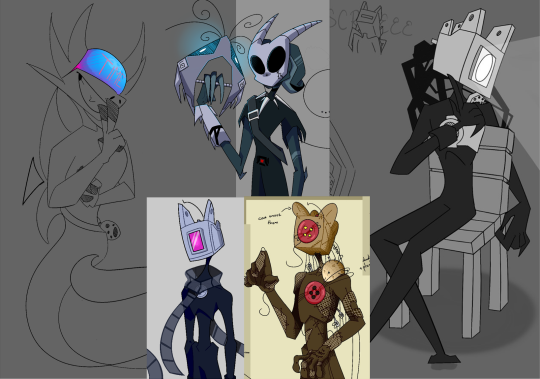
This was mostly because going Sharp and eliminating more rounder parts made sense in my head and helped me somewhat learn anatomy better. At least, in some cases it gave me a lesson about the torso to arms proportions n also kinda the legs. It’s why I recommend just kinda entering a stage where you just try and make sense of things, whether it be geometry, perfect straight lines or the more spherical ball things Ever. Going with the “basic shapes” like a circle for the head, triangle for the torso n so on might not be smth that will click in your brain
I was KINDA obsessed with learning anatomy as soon as possible even tho you don’t really have to go after that. One time I saw a pyramid of needs but like for artistic learnin and anatomy/realism were somewhere far on the top. Just go after what sparks the most joy, basically, but I didn’t know that back then so after every shower I would check out how my own body looks like from different angles. Yknow, thumbing where the rib cage ends, how does a shoulder connect to the torso, what the fuck is an armpit and how in the complete shittery does the neck connect to the head from the front
Cut like two years later, I think I’m enterin the Flowy arc
For the flowy, you KINDA disregard everything u’ve learned about anatomy Except the general idea of the proportions. I like to think about my drawings as part of an animation. From the picture that I’m making, there has to follow another and before it were also a few hypothetical drawings and together they gotta make up a movement. If I can’t see my drawing moving in my head, I’m not gon be too happy bout it
The main thing you want is a line of action:
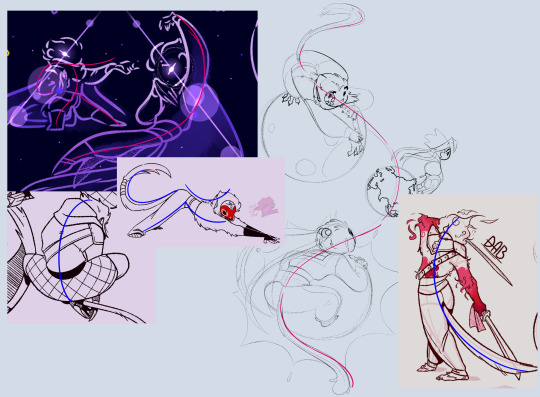

And then you just,,, kinda build the body around it
Finding a brush that feels good and lets you develop a sketch style that makes u happy and lets you figure out where what goes cleanly also helps out. For me it was Luv and the the more faint sketch lines that u see up there ☝ give me enough space to be KIIIIIINDA messy about it but not overbearingly so to the point that I don’t know what’s goin on anymore
Practice, practice, take inspiration, study other people’s styles, disrespect anatomy, practice some more, don’t put too much expectations on yourself, don’t take every art “advice” too much to heart, let go of perfectionism, practice and you’ll get it!

#Spot says stuff#important thing about art i think is open-mindness. you want to find new ways to go about things n not get stuck on a thing#once saw an 'advice' that said one shouldnt make lineart like. allign. n i said 'like fuck im gon do that thats one of the Main Bitch-#-things of my style and it SLAYS' so basically do whatevs that feels good n not what peeps tell u to do
50 notes
·
View notes
Note
hiiii, I really love your art, I think you're really talented. and I wanted to ask how did you learn to draw anatomy? would you have any tips for begginers? it's so hard I swear😭
thank you!! and you're right anatomy is tough, i learned anatomy (and am still learning) via figure drawing classes and figure drawing practice, as well as a variety of internet tutorials/studies, plus a few old anatomy books i pinched from my parents back in the day
there's tons of resources online for anatomy and figure drawing, i use croquis cafe and line of action most, but there's lots of others that are just as good! also doing studies of artists you like that have a solid grasp on anatomy and technical drawing can be really helpful, to see how they simplify and exaggerate. you can find really good examples of that kind of stuff in official art books (disney/pixar/dreamworks/sony have some really good ones for their animated movies - look for model sheets and pose sheets! also personally i love design explorations for background characters, they tend to be made up of really fun shapes and interesting structures. if you dont want to buy them or cant find them in a library you can find some scans online if you dig)
also anatomy can be super overwhelming!! there's lots of moving pieces in the body and trying to get it to look right can be frustrating, I find it easier to just focus on one bit at a time. Draw loads of arms for a while! By that i mean while figure drawing just isolate one body part and try to break it down - you can do research if you want and study muscle groups etc, but honestly the more you draw something the better you'll understand it intuitively regardless of booklearning. Once you have a pretty good idea of that one bit, move on to the next and the next, then you can study up on proportions and put it all together.
mostly though: do lots of fast little shitty drawings! dont make them pretty or good just do some drawings and finish them as fast as possible and then move on!! learning through repetition is no joke and the more you can draw the more you can learn
88 notes
·
View notes
Text
“Tell Me What Happened:” Zutara and the Female Gaze
I’ve seen some discourse about the male and female gaze, and I think some people misunderstand what these terms actually mean. So let’s go back a bit to the origins.
The term “the male gaze” was popularized by feminist film critic Laura Mulvey. In her essay, “Visual Pleasure in Narrative Cinema,” Mulvey uses the Hitchcock film Rear Window, which is a story that is entirely framed around the voyeurism of the main male character. There’s a point in the movie where the protagonist’s girlfriend, who had previously doubted the events the protagonist claimed to view out of his apartment window, which make up most of the action of the story, finally comes around to his way of seeing things, and delivers the very effective and famous line “Tell me exactly what you saw, and what you think it means.”
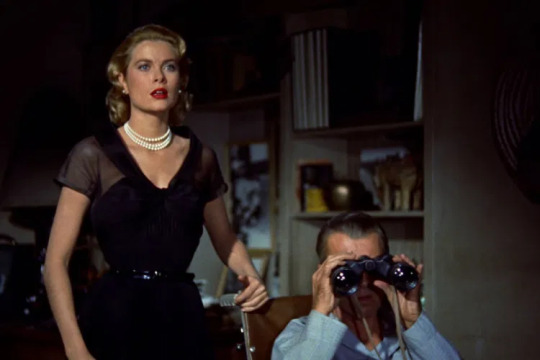
Most of the time when people talk about the male gaze, they refer to female characters being displayed as objects for an assumed male viewer. Mulvey argues that the way the character Lisa is portrayed in this movie does subject her to this voyeuristic interpretation, but it goes deeper than that. When Lisa is not the object being viewed, she is asked to see things through the perspective of the main male character. She originally doubts him, but eventually she is forced to view things from his perspective. Later in the movie, she becomes subject to the protagonist’s gaze as we see her on the other side of the binoculars. Her boyfriend, the character through which the movie establishes its viewpoint, watches her be threatened by another man and eventually she is saved.
The movie both invites the assumed male viewer to view Lisa as an object AND asks her, as the movie’s female protagonist, to view things through the lens of the male protagonist.
And that’s what most of the critiques I see of Katara and Aang’s relationship are about. Take “The Fortune Teller,” for example.
Many people have already talked about how "The Fortuneteller" treats Aang's crush on Katara vs Meng's crush on Aang, but I would like to point out what I think is a particularly egregious example of the male gaze in this episode.
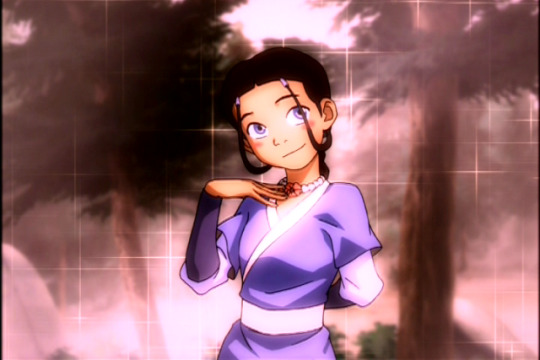
This is Aang looking at Katara. We get the pan over her body with emphasis on how attractive Aang finds her to be. The lighting makes her look practically angelic.
Then, later in the episode, when we see Meng crush on Aang, we get a similar pan.
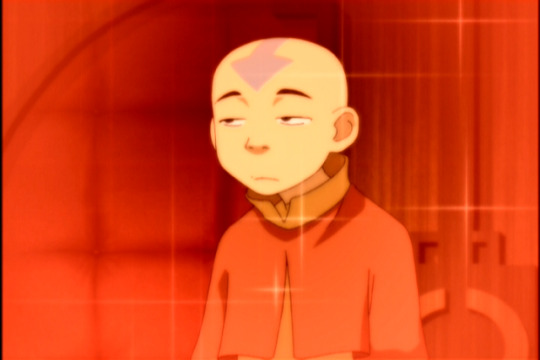
The joke is meant to contrast Katara's desirability with Aang's, yet we are supposed to root for Aang as he worries that Katara does not return his feelings.
The show is also making fun of Aang's crush on Katara by showing Aang's exaggerated perspective, but she still remains desirable in his view and to the camera. There is no undercutting of Aang's view of Katara the way the camera subverts Meng’s view of Aang. We are not asked to see Aang as desirable from a female perspective, which begs the question of what Katara should see in him if female desire is so, well...undesirable.
This is one of several places where the show is self aware enough to poke fun at the way Aang sees Katara, but still in the end totally validates him and the male gaze by only subverting it when the genders are flipped. Which isn't actually a subversion at all.
This is an example of the camera framing a female character as object of the male gaze, but it goes deeper than that. The male gaze isn’t just framing women as objects to be looked at, but inviting women to view themselves through the filter of the male gaze as well.
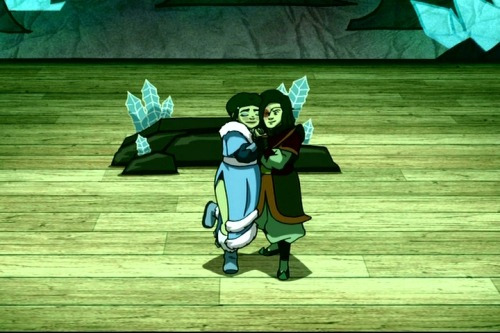
And therein, I would argue, is the appeal of zutara.
You could make a case that one of the reasons zutara is so popular is because the show does occasionally present Zuko as an object for the gaze of a female audience. The creators were aware at a certain point that there was a not insignificant portion of the fandom that was into Zuko.
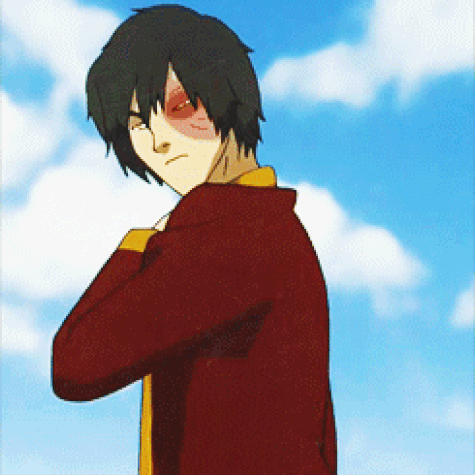
But Zuko is never framed as an object of desirability for Katara.
What the show does do, though, is switch up the lens through which we are supposed to view the narrative. And the way this happens is directly tied to Katara’s relationship with Zuko.
Katara is, in a lot of ways, our narrator from the beginning. Her words are the first ones heard from episode one, telling us about the world and the war and the Avatar. Her narration is focused on Aang and his story. “I believe that Aang can save the world.”
Katara also has her own story, though, one she talks about throughout the series but mostly in relation to others. And it’s this story that she confronts Zuko with in the crystal caves, when she tells him that he has “no idea” what she has suffered, and she tells him about the death of her mother.
Zuko does something she doesn’t expect by apologizing and relating it to the loss of his own mother, but he still can’t fully commit to her side and ends up betraying their tentative truce. It’s when she confronts him with it again in “The Southern Raiders” that things start to shift.
Before that, Katara had used the death of her mother to empathize with other’s loss, and many times this is a male character. We’ve heard the story told many times. Sokka tells it to Toph to explain Katara to her.
When Zuko seeks out Sokka in “The Southern Raiders,” though, it is the first time that another character has asked to hear the story.
Zuko: I want you to tell me what happened to your mother.
Sokka tells Zuko the story and tells Zuko that it’s not something he likes to think about. This relates to how Katara and Sokka differently view what happened to their mother, and partially contributes to why Katara told Sokka that maybe he didn’t love her enough. For Sokka, the day of his mother’s murder is not something he wants to relive, but Katara is constantly forced to relive it.
“The Southern Raiders” contains three full flashbacks to Kya’s murder. First from Sokka’s viewpoint, then Katara herself as she is telling the story to Zuko. The last time we see the story play out, it is as Katara is standing in front of Yon Rha and confronting him with it, while Zuko looks on passively.
Here, the dynamic has shifted so that Katara is not only the one telling the story, but in the end she is also the one who gets to rewrite it, to define how it ends, and Zuko is the observer, much like Lisa in “Rear Window.” Tell me what you saw and what you think it means.
Zuko knows the importance of letting Katara give shape and meaning to this story because he himself tried to do the same with Ozai, who is the only one left to speak about what happened to Ursa.
Ozai: Don’t you want to know what happened to your mother?
That both of these narratives involve women being silenced emphasizes the reclamation of them as the shifting from a male gaze to a female one. That Zuko’s redemption is tied to such a shift is very interesting, especially given the elemental symbolism of fire = male and water = female. That “The Southern Raiders,” one of the most shippy episodes, involves Katara ignoring Aang’s attempts to define the situation and, in the episode’s climax, forcing two male characters to observe as she describes what happened to her mother, a woman she is so connected with, is significant. Katara directs both the gazes of Zuko and Yon Rha, and by extension the audience, just as she effortlessly directs the rain itself. The last time we see the memory retold it is Katara revealing the truth to Yon Rha, who thought he had killed the last waterbender. The fact that this episode was penned by a woman also emphasizes the power of reclaiming narratives with a female gaze.
236 notes
·
View notes
Photo
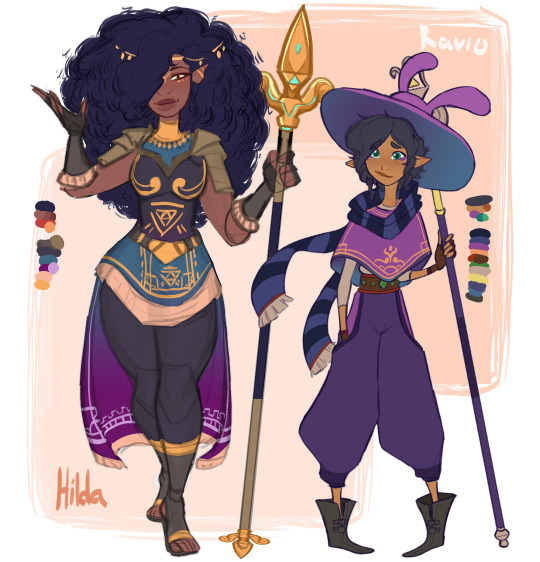
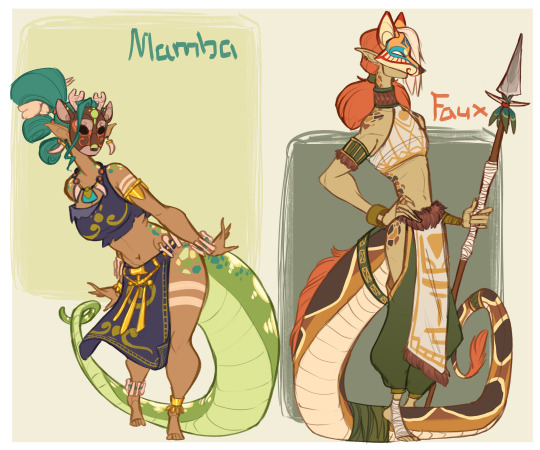
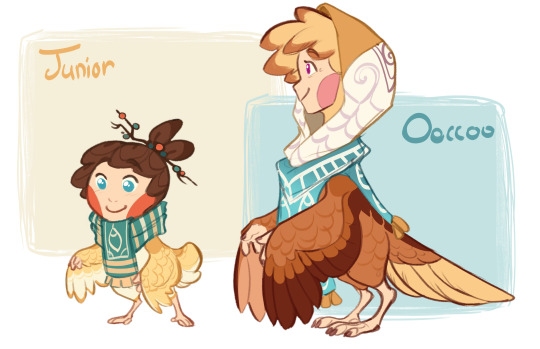
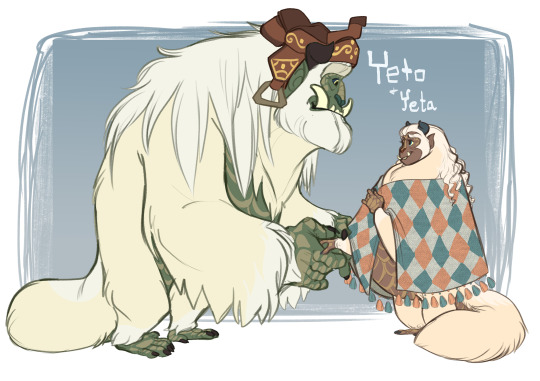

FINALLY! After a little while of work I’ve finally designed and drew each of the main races for Lorule! So that means, LORULE HEADCANONNNNNNNN!!!!! 8D aight ya’ll, let’s get right into it:
-----
Lorule is one of the Seven Kingdoms in the world of LoZ (not sure what to call the actual world itself), and the direct neighbor to Hyrule. Despite its harsh climates and highly varying regions, Lorule is prosperous and a staple realm among the Kingdoms. It’s ruled by the queen Hilda and inhabited by the following races (alongside some lore bits for the characters representing them):
-Lorians: A people who are of the same race as Hylians and thus share the trait of having pointed ears. Lorians, however, commonly have darker skin tones and lighter eyes, raging from copper brown to golden yellow in contrast to the common greens and blues of Hylians. While scattered all across Lorule, their capitol resides in the center of the vast drylands, smack-dab in the middle of an oasis.
Queen Hilda is the current ruler of Lorule and the youngest one to assume the crown (she became queen at the age of 16). She gained her position due to her father stepping down in light of ailing health, and has since earned a reputation of being a just and competent queen. She's strict and can be intimidating with how no-nonsense she is, but does whatever she can to do right by her subjects and allies. A bit of a big sister/mentor figure to Zelda.
Ravio is a young farm lad who has big aspirations to be a court mage. Thin as a rail with a timid, shy disposition to match, Ravio scares rather easily, but he works hard and dreams big for his future. He was taken in by Ooccoo when he was just a baby, having found him hidden under a blanket within a ransacked carriage. He idolizes the Queen and wishes to be as strong as her.
---------------
-Yamatami: This race of humanoids are as tall as they are lean and thin, characterized by their unique masks they never take off and their ability to transform into giant snake-like creatures. The Yamatami inhabit the marshlands and mostly keep to themselves, though they are highly sought after trading-wise for their venom. They are lead by the somewhat oafish chief King.
Mamba is King’s daughter, and therefore the next-in-line to be chief once he steps down. As much as Mamba adores her tribe, she longs for a life of adventure, ever so curious about the world beyond their marshland boundaries. Part of her hesitation on being chief secretly banks on her fear of not being fit for the role. She’s a dreamer, very bubbly, friendly, and somewhat naive, but all she wants is to be able to make her own path.
Faux (pronounced “fawks”) is resourceful, fast, and cautious. They’re one of the best warriors the Yamatami have to offer, and through that they’ve become the trusted bodyguard to Mamba. Faux might seem indifferent to the overtly friendly princess but don’t let that fool you; they are ever watchful and ever so protective of their charge.
---------------
-Oocca: Bird-like race with human-esque faces, they are a peaceful people who inhabit a great city hovering in the sky. The Oocca dislike conflict, though this is possibly because they themselves have no means of self-defense nor combat prowess, though they more than contribute their fair share to the Lorule alliance via their expertise in trade and commerce, as well as their advanced technology. Given their general lack of combative means, their city is inhabited by guards from the other native races, as per their negotiations. Anywhere you go, there’s almost certainly an Oocca merchant handling the finances of the city.
Ooccoo, sometimes known as Miss O, is the sweet, gentle single mother of Junior. She makes her peaceful living running a homely inn and selling knick-knacks in the small farm village Ravio grew up in. She also doubles as the resident repair shop, using her skill in tinkering to keep the village's tech and tools in tip-top shape. Ooccoo has a knack of taking in any stragglers that she may run across, which has led her to taking in Ravio and raising him as if he were her own. She has an unusual assistant: an old battle-worn Lynel (to be designed later!) she calls Lyo.
Junior is Ooccoo's outgoing young son. Ever so eager to make friends and lend a hand whenever he can, Junior helps his mother run her inn and shop. He's high on energy and sometimes runs too fast for his legs to carry him (he has a penchant for tripping), and someitmes he talks a little too much, but all he wants to do is make sure you feel welcomed when under their care. He often uses berry branches as hair ties so he can have a small snack anywhere he goes!
---------------
-Yook: Otherwise known as Yetis, they are a race of huge, gorilla-like bipedal creatures who live on the peaks of the freezing, snowy mountains of Lorule. Despite their fearsome appearance and gargantuan strength, they're rather friendly, and have been known to guide lost hikers back on the trail to return home. Unfortunately, the Yook were once hunted to near genocide for their thick coats and tough hides before the practice was outlawed, and so they're cautious towards outsiders. It's only recently that they've begun to allow visitors to their humble village, but the current political climate among the Yook is a tremulous one.
Yeto was once the leader to the Yook before being beaten in a fight for the title against his younger adversary, Yuk. Now he and his beloved wife Yeta live out in the outskirts of the hidden village, living a quiet life while dedicating themselves to helping lost travelers and keeping them away from the village. This is mostly because, under Yuk's aggressive leadership, the Yook village is not safe for outsiders.
Yeta is Yeto's soft-spoken wife. Yeta is motherly to a fault, with barely a hostile bone in her body, but she isn't one to be pushed around. Upon her husband's defeat to Yuk in combat, she was outspoken on the harm he would cause their village by leading them down a violent path and was the only other one to stand up against the newly crowned chief, the others too afraid to say anything. She and Yeto were then forced to leave the village, living on the outskirts and dedicating themselves to keep outsiders away for their own safety.
---------------
-Mogma: Andromorphic mole-like peoples who make their homes in the dry grasslands, the closest neighbors to the Lorian capitol. They generally grow to be large with huge, long claws for digging, and their villages and cities are known to mostly reside below ground. They are largely artisan by culture, focusing most of their energies in making, and collecting, knick-knacks and treasures. Their drive for all things shiny and pretty make them excellent treasure hunters, and many Mogma make lucrative careers out of being treasure-hunters-for-hire. They are a semi-nomadic people.
Guld was once the leader of the Mogma before he finally stepped down and gave the title to Ledd. One of the few Mogma to make his residence above ground, Guld has retired to a peaceful life of farming and selling pumpkins and other little trinkets he finds during his evening strolls. Despite long-since stepping down as leader, the Mogma often seek him out for guidance still, and he’s worried that it’s because they aren’t trusting their new leader as much as he’d hoped.
Ledd is the newfound leader of the Mogma, chosen by Guld for his courage and finesse in finding treasures. For all of his perceived confidence, Ledd is unsure of his newfound position, and his lack of action has led other Mogma to believe he is unfit for the role. His only supporter is Plats, his best buddy, and Guld. He’s determined to prove that he wants to be the leader the Mogma deserves, but is unsure how to do so.
Plats is the kindly and rather nervous buddy of Ledd, and the youngest brother of three. Unlike the rest of his kin, Plats is far more interested in simply trading items and hunting for food instead of shinies, which contributes to his round figure and his resident duty as town merchant. Given his rather cowardly disposition, Plats rarely ever tries to go treasure hunting, something his brothers often tease him about. He is the only one who has faith in Ledd’s leadership among their kin with the only other exception being Guld.
---------------
WHEW!!! That got a bit long, but I’m glad to say that it’s out there for ya’ll to see! :3 I had a whole lot of fun working on this headcanon and if you have any questions please feel more than free to ask!! ;w;
---------------
More LoZ headcanons | My Patreon |
#loz#nintendo#Character Design#legend of zelda#breath of the wild#botw#nintendo headcanon#loz headcanon#princess hilda#ravio#mogma#yeti#oocca#yamatami#lorule
865 notes
·
View notes
Note
How do you figure out how to panel each comic page? Do you think of it before hand or do you just go with the flow as your drawing?
Think of it beforehand and Write a script. Write out what is happening in each panel beforehand and any dialog that goes in that panel.
I don’t follow my panel descriptions 100%, but having that script really helps.
My panels are a combo of the script and going with the flow because some things just don’t always work how you plan them out beforehand, but you need a building block.
I also think in terms of pages, but this took me a while to get use to, and I wouldn’t expect anyone to be able to do this right away with their first comics. Page layout also doesn’t apply to web comic design which has different paneling techniques than comic pages which are meant to be turned rather than scrolled.
(Note: I’m all self taught. I’m pretty sure there are rules out there somewhere about paneling, but I’ve not found any in English yet. I have found some small rules from Manga artists but I’m sure there’s a beautiful set of standard paneling rules that would be amazing to get ahold of if only I could)
Every comic artist has an art style, but most people don’t think about panel style. This highly effects the flow and drama of a story. Just think about how Jo Jo’s Bizarre Adventure can make anything dramatic. This is due to perspective and of course, panel selection :)
I’ve seen artists with amazing skill not have the best paneling, but I’ve also seen some average artists have amazing paneling. I’d say the ability to panel means the story is interesting and people will be more forgiving of the art if the story is good, so... do some panel studies from comic/manga artists you love and figure out what they’re doing with the panels to make the story better. Everyone has their own panel style and it makes a huge difference. (Also read Understanding Comics, by Scott McCloud)
Here’s my tips.
Each page should encompasses an idea. Don’t start a new idea halfway through the page.
In manga, the last panel on a page is called the page turner. End the last panel on a page with something that would make you want to turn the page.
Large panels are for important ideas. Small panels are for minor actions with very little text.
Irregular panels can create motion or distortion. A panel that is pressing down on a character can make the character feel weak. A panel that is pressing up diagonally on a character makes them feel actiony. (this is the panel shape, not perspective, which can also help with these feelings)
There are such things as full bleed or open panels. These are panels that are drawn to the full border of the page and not contained by black lines. These are good for establishing shots or setting the scene or tone.
Panels can have a double line “gutter” or one line separating them. I’ve found that gutters are better for when the camera makes a jump to a different idea. Single line separated panels are for a string of consecutive thoughts that somewhat tie together.
Some panels can have borders, but bleed to the side of the page. IDK why I do these yet, but I feel like it’s mostly for either more space or a hybrid of open and closed panels.
Plan for where your text will go. Text should force the reader’s eye to travel through the panels. The order of reading the text and looking at the picture affects the readability. Sometimes you want to hear the text in your head first before looking at the image, and sometimes you want to see the image and then read the text. This depends on what is going on, but for joke punchlines, it can really have an impact.
I’ve found a general rule of 6 panels per page is good for pages with less action. Aim for 6 panels unless you have an impactful scene. For me, splitting the page up into thirds and then further sub splitting those panels works best so that you have one large panel and 5 smaller panels.
Try to have a panel that shows where the characters are in relationship to each other and the background every page, or every other page. This will keep your readers from becoming confused. I’m bad at this!
If you’re starting out, my first suggestion is to ask if you are still at the point where you are ordering your panels with numbers for the reader. Work on not needing to do this. The reader should naturally know where to read. Then work on leading the reader’s eye with text. Then something else I stated one at a time.
Do not start your big comic all at once. Do some small jokes or a short few page story's the first time. This is what I did till I felt more comfortable paneling. If you have a big comic idea, you aren’t going to be able to do it justice if you haven’t practiced, and you’ll end up putting it off in fear of not doing it right. Aim for small comics till you feel more comfortable about the process.
Finally, watch this video, and other’s by the same channel
https://www.youtube.com/watch?v=MIUWPqxmD2w
224 notes
·
View notes
Text
The Diary of Doctor Laszlo Kreizler
Chapter 1 - Chapter 2
Synopsis: Alienist’s notes are private, sometimes gruesome, secrets of others and of himself.Those pages belongs to secrecy and decadence, have a glimpse to this world made of drafts, notes, accidents and reflections. Or maybe it is you the only person that should ever reach for it.
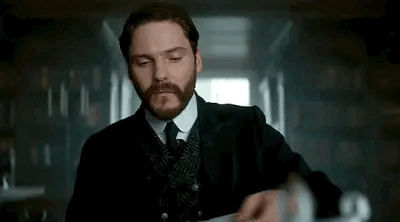
While you read this imagine Laszlo mostly at the end of his day, scraping the ideas and the thoughts, adjusting previous notes with additions, closing the day behind himself with a couple of sentences while sitting in his evening robe, a good glass of whiskey and his glasses bridged almost at the tip of his nose. Or maybe imagine yourself, you sneaky thing, reach for it from a far shelf.
Word count: 3.5k
Warnings: listen, this is the set of ideas and confessions of a man living in the 1890’s. Most of them will be outdated, rough, even deprecating in some analysis of the roles of men, women and social status, religion, etc.So be prepared, my point is to make Laszlo reflect upon those topics, but to be as faithful as I can to his time. Mention of death, mutilation, self harm and sex. Psychologically troubled young children ahead! Author’s note: The story is placed between season 1 and season 2. Thank you for everyone that encouraged me to keep going. I have to wait for my local drop of serotonin to get fully Laszloed to go through this.
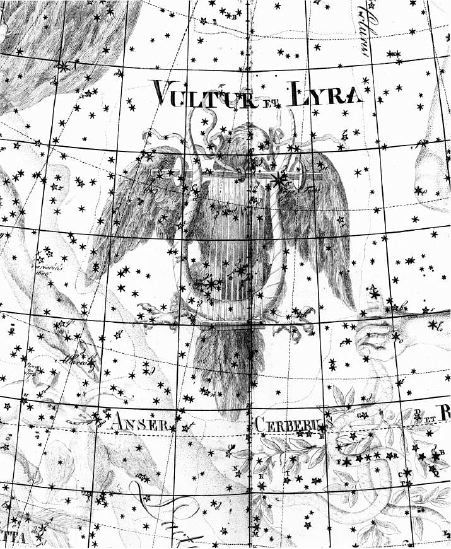
Lyra’s Contellation, Illustration taken from Uranographia by Johann Bode
Routine. Routine is comfort. Habit stabilises the character.
If you follow a routine, you won’t ever be victim of imprudence, of evil jokes of fate. The stability earned through calculated and repeated actions brings a sense of fulfilment that forbids other thoughts to come bashing in, breaking rules, breaking hopes that a solid scheduled routine forbids to have. I take my time to begin this week, I planned the things to do, the next steps for the case, the people to meet, the resources I am allowed to contemplate. I feel good, I feel back to myself and the events of the weekend seem far from me and my own perception. I probably got ahead of myself, carried by some instinctual though and random rush of emotion, to be always in contact with the same people and mostly kids probably doesn’t help my stance in the presence of other adults. I feel silly now reading back the last page, I felt tempted to tear it off, but to keep it there should be a small memento of not losing my temper so easily. I read it over and over and I know I am not as charmed as I thought I was. I am just lonely. I have always been and it is normal to face ups and downs even for a man of my age who is more accustomed to it. To desire a partner is a natural instinct, to find somebody attractive is meant by nature, it is the body calling for the natural fulfilment of the reason we are put on this very Earth. But even in a state of nature my own condition would be forbidding me to be part of the natural process of growing my own kind. I am the type of male that would be excluded because of his impossibility to give the protection to the pack, therefore it is just more reasonable to me to adapt to my condition. No matter what my Potentia generandi might be (the ability to procreate).
With all the smugness that characterises him, Niki showed off that he passed my challenge. But to be really of an help to his antics I didn’t show any kind of surprise. I treated him like he did the bare minimum, like he didn’t prove me any kind of superiority. He has a natural attitude toward challenging the figure of power, he is trying to overpower me, but I won’t satisfy his need. I have noticed he has a very technical brain, he finds ways to solve problems in ingenious way and not by throwing himself into the task. I proceeded giving him to work on a clock, an old broken one we had in the institute, one of the kids hit it with a ball years ago and nobody ever worked on repairing it. I gave him the clock, a couple of screwdrivers and a book. He called me a number of German names I won’t transcribe, but it gave me a certain amount of satisfaction. If my intuitions are right, I am sure the clock will be repaired by next week.
Analysis of the victim’s body through John’s eyes. The drawings and sketches are as detailed as I requested, all of this thanks to you joining him. I deal with art critic section, I am used to notice these things. You assure me, you play yourself low and I wonder why, nevertheless you did notice things neither John or I did, which pleased me. It fooled me, distracted me from my purpose to not give in to your witchery, as I leaned closer watching your pale hand move across the pages tracing this or that line, showing how this must be done with the killer on this side and not that side, with words so deliciously elaborate, your way of composing your speech is compelling, you could sell the drawing of a kid like it was a Botticelli. I noticed the shape of your hands, the way you move them, I wonder if you play an instrument, or played, some habits just stick with you through life. I focused on taking notes, your ideas and instructions giving me a new point of view, a new stimulus. What if that is the only way the killer can communicate? Or what if this is the communication that works for him? Could our killer be mute or deaf? Or that’s how society made him feel? This man, or woman, needs a listener and I am afraid that now, since he got our attention and the public’s, he won’t stop. Another killing could be just as close.
Scheduled: meeting with the parents of Alex Garel for new admission, Monday next week at 11 am. Love at first is a fetish and like all fetishes it is based onto an object that hides a deeper meaning, like gloves mean hands, to love at first sight means to see somebody that you think, and think only, to have the chance to share not only a sensual kind of bond, but an intellectual. Love at first sight is based onto not knowing someone well enough, but having the time to idealise most of that someone. I can see why I feel this attraction, using a particular phrase that Sara often mutters when investigating: you tick all the boxes. I know you do, your beauty is everything but conventional, you’re the kind of face that painters would paint and musicians would write hymns about, but any animal on the street would never be allowed to see. You have the grace of the body and the fire in the eyes, and then you speak. When you speak, I realise, you could bring the world to its knees. Also, you never speak out of context, and if you do it is to ease somebody’s position. You do it often with John or with Stevie, you say something really silly in order to put them back to a place of comfort. Some women would call it self deprecating, but I see that you only pick wisely your fights and your wins. You don’t need to earn your peace and quiet by neglecting, but by lifting up the others. I wonder if you do it with me too, if your silences are just you allowing me to be in a better place while instead your judgment is tearing me apart. I shouldn’t care, but I keep wondering, sometimes I take my time to answer you, I analyse every shade, every peculiarity of your question, I am looking for sarcasm, for a condescending voice, for something to hang on and bare you open. To prove myself you’re not perfect. But deep down I know that you do, you judge me and you do well.
Mother never said so. That’s what one of the girls in my care said today. Ursula. She is tough. Skin as thick as an alligator and the tendency to pull her own hair at night or when under a massive amount of stress, enuresis alongside erratic episodes of mutism. I tried the soft approach, it didn’t work. She is too accustomed to be indulged. Therefore today I pushed her a bit overboard, I teased her over opinions on the female body, the female role, she is only 12, but she is soon to bleed, she knows, I can tell from the way she clenches to her skirts, from the way she looks at me as a threatening figure. I am the incarnation of danger to her. Under her steady silence, I pushed a bit more, asking how her mother taught her to be nice and submissive. Does her mother tells her she is going to be a good wife? The phrase, which I reported at the top of the page, surprised me. What is her mother teaching to her then? What closed her so much, locked her soul away, making a small bird like this choose the silence and the retirement of self inflicted pain over, what? Mankind? Or just Men? Is that even a curse? Should I cure her from a truth that her own mother whispered to her ear one night before bed and made a child decide that the world wasn’t a place to share her time with? Am I the man supposed to teach her that men are worth of trust? In the eyes of modern society, who measures its own value over the modesty of the women, she would be a champion, but at what price? I can’t in any way let her parents bring her back home after our recent meetings. Nevertheless, I have to make up my own mind on how to give her troubled soul ease without making her believe in fables. I, as a man, regard myself not worth of any of the trust they expect me to teach her.
In all of my years practicing with people’s feelings and traumas, I challenged myself to find those same traumas within my own mind. It is a tricky game, terrible, anguishing at times. But it straightens me, the pain of others, the pain of kids mostly, so unadulterated and pure, breaks the curtain between me and the lies that I often surround myself with. Pain is made of method, you can open it up, you can scrutinise it, part it piece by piece dividing it in sectors and, partitions, centre part, side part, heart of the problem. Pain is reliable. Happiness is not. It is random, cruelly sudden, unexpected, it washes over you in such deflecting way only to leave you alone a moment after ashamed and alone. I saw you again today. You were in a table full of what I could only guess as your former university colleagues, I saw pain in you, not heavy but constant. Annoyance, a bit of sadness. Your head titling on side and your eyes drifting on the left, you’re imagining something away from them. A place? An object? Or maybe someone? Your hands play circles at the bottom of the flute of your drink like kids do, your smile only one sided. I don’t see you speak at all, only listen. What could keep your voice down? I almost gulped down my own breath as you looked up and I realised how I must have looked. I was having lunch on my own, in a very private table and even entertaining myself with a newspaper on the side. I wish you didn’t, but you came over, your eyes shining. Did I save you? Or maybe I was just a good excuse to leave that painful meeting behind. Don’t be so nice to me, it is not healthy. Don’t look at me like you expect anything more from me than me listening. I won’t smile back at you, I won’t give you care, attentions or thought. I won’t lean for your perfume, I won’t obsess over that dress you wore, that pin that adorned your neckline keeping your undershirt in place, a silver robin, I remember. I won’t remember the number of the buttons on the side of your glove, three. I won’t observe the little moles just under your ear. A small constellation, I later realised, hidden between your ear and the beginning of your neck. I don’t need to check in my books. It is a constellation. It is Lyra. Why? Why you must be like this? Are you the Lyra? Are you the instrument of Orpheus come to me to drag me out of Hell? The Tartarus holds my soul and you should know already, I am not worth the quarter part of Eurydice to be saved and she never came back anyway. I won’t be now recollecting the way your teeth sunk in the inner side of your cheek when you apologised for the annoyance. You apologised twice, I ignored you both times with a raised hand to request peace and silence. I am not letting you in.
Reserved: Tickets for Wednesday’s evening Traviata by Giuseppe Verdi. The guest female lead promises a beautiful show.
Leonardo, as I am learning through Paul Valery essay, is who I would define as a figure of projective identification of the Subject or, to better explain it, of the knowledge of the Subject that formed and grew through the use of sketches in the experience of the Artist. I have always thought that the finest form of art was the representation of knowledge duly undressed by any personal identification. Leonardo, instead, proceeded to represent the figure through the essence of the artist, a representation technically unlimited on objects and symbols and that keep expressing the transformation and development of Leonardo’s own being.Some artists are testimony of the destruction of the world, of the loss of eternal beauty over decadence. And then you have Leonardo, who creates an art that is the gravity of the world’s system, of the nature, of thoughts and abstractions. I wonder if our killer does the same, if the way they presents the victim through their own personal view, if what we can read there it is their stories, their pains, their needs. Their happiness and troubles. What are they trying to tell me? I need to know, I need to know to save a life, of course, but I also need to know to be able to sleep at night. Hair, hair are the epitome of femininity in any era. I keep studying Ursula and her habit to pull the. I took notes on it: she picks them by the bottom, slowly separates them until she gains an amount her mind defines satisfactory and then she rolls her finger and pulls, she does it until her finger is empty and there are no hair left. I find her process incredibly interesting. In men’s case the display of physical attributes is not as vital, a beard can be appreciated but does not modify the power of seduction of a grown man. On the contrary, for women hair are a vital part of their attractiveness toward the opposite sex, society sees the hair of a woman as part of their vital characteristics, also in ancient times for a woman to cut her hair or have her hair cut was a sign of deep separation from the society. Only heroines or whores wore that mark and the association of the two is so rooted into the way society always parted the role of a woman in two that it is nauseating to think of. I am still fearing to let Ursula go away, the repulsion that she is showing toward her own body makes it difficult even for me to crack her shell open as a man, but my deepest worry is when that hate will take a scarier and deeper tool on her. How a girl with such a fear of what her body can do, like sex or pregnancy, can endure in the future to have an husband? Or even to be courted by anyone?
John is helpless and I admire him for that. He doesn’t hide it, he just is. He is vulnerable and exposed, he is an open well bursting with doubts and feelings and troubled waters. He is genuine in a way I could never be. Maybe that’s why I despise even more him talking about you, how he sees you every morning, how you greet everybody, how you behave even with interns, how you like your coffee. Your talents, your wits, how you said this and acted like that and reasoned through him. How you forbid him to drink even when he felt tempted. How you stayed late over to help him collect all the informations I requested him to get. To him. Not to you. The evil demon of envy scratching in the back of my head screaming like a siren out in the sea, he demands to be heard, he demands to be allowed a part in this game. I won’t allow him that. I won’t allow myself any of that. This is a pure game of chess, if I give in a pawn now, I will lose my knight, and I know it. I advice him to not be so closed minded when he praises you, only to get surprised by the charms of a natural logical mind. I find a way to hurt him, he is an easy target, I look at him as his eyebrows twitch and he summons his patience on me. He lost the plot about you already, his bruised pride taking over. You won’t come into my life.
“Un dì, felice, eterea, mi balenaste innante, e da quel dì tremante vissi d'ignoto amor.” (“On a day, happy and ethereal, you appeared in front of me and from that day, trembling, I lived on an unknown love”)
The words of Alfredo in the first act of the Traviata keep running through me, a chant that won’t let me go, almost painful. The Opera House, that was my hiding place, a place where in plain sight I could let out myself, unleash. The catharsis of the characters involved running through me, I didn’t need anything but their voices and those musical instruments to let out my fears, doubts and anger. When Alfredo came to the scene tonight, the lights were strong and slightly pinkish, the performer bursting out of the seams with passion. My eyes diverted only to see you there. Alone. Those blinding lights gave you the the radiance of a vision singing the notes of greek myths and heroes, that dark blue evening clothing rang through my eyes like it was a bright yellow, the little shiny details that adorned you so clear against the heavy lighting to look like transparent pieces of water collected to adorn your beauty. I wasn’t me, but Alfredo, and I was helpless against you sitting so far and yet too close from me. I was naked in front of thousands. I am aware of the effect you have on me and our last conversation was barely regarded as one. This is infatuation, this is the pure work of a lonely mind and not something worth of any of all the words that I am dissipating here. Yet. I saw you cry at the climax of the opera, Violetta, the protagonist, heartbroken falling on stage consumed by pain and regret for her lost love and ultimate sacrifice. Your eyes shone as you tried to hide the tears and collect yourself. Through my binoculars, I saw your throat tremble and gulp down something more than just a sigh of pain. Your jaw clenched, your gloved hand moves to hide your shaking lips. I reckon, I have never seen such sad lips look more inviting. You look at the wall on your side breathing through your nose and not even that can save you by the strength of the voice of the soprano. You’re defeated and so you brought a fine silk handkerchief to your eyes, your shoulders bent inward in self defence. The Opera won. It won you like it always wins me. I wonder if you felt like this because of a past lover, somebody that broke your heart and made you feel wrong in any way. And because of that little wonder it is even more clear to me why I am a man worth of no trust. Because for a moment, I know, I wished to be the one that broke your heart. That gave you just the pain you’re inflicting on me so mercilessly by offering intoxicating kindness and beauty. To own your thoughts, tears and shame. To be the one man you have to look away from. I want to own all of that and, maybe, I will be freed of you the day you’ll be just another human being that hates Dr Laszlo Kreizler.

Tagged @cazzyimagines @lieutenantn @handmaiden-of-mischief @thesunflowersutra @zemomybeloved @fictionlandslanddreams @charistory @greeneyedblondie44 @apparrio @hb8301 @whatawildone
Let me know if you want to get tagged too <3
#the diary of doctor laszlo kreizler#dr laszlo kreizler#laszlo kreizler#dr laszlo kreizler x reader#dr laszlo kreizler imagine#dr laszlo kreizler x you#laszlo kreizler x reader#laszlo kreizler headcanons#thealienist#the alienist fanfic#the alienist fanfiction
74 notes
·
View notes